



Maximising Carbon Dioxide Content of Shell Eggs by Rapid Cooling Treatment and Its Effect on Shell Egg Quality
The rapid cooling of shell eggs with liquid carbon dioxide extends their shelf life, according to news research from Purdue University.Rapid cooling of shell eggs using liquid carbon dioxide has been shown to cool eggs to 7°C within minutes, as opposed to days required by traditional cooling treatments, according to a paper published in Poultry Science recently by P. Banerjee and K.M. Keener of Purdue University. This quick-cooling technique is component in the maintenance of egg quality and extended shelf life beyond the current 30- to 45-day period.
The hypothesis for their current study was that maximising carbon dioxide content of the eggs during cooling may increase Haugh units and thus extend shelf life (physical quality factors).
Their objective of this study was to maximise carbon dioxide content of shell eggs during rapid cooling with liquid carbon dioxide and determine its effect on egg quality during 12 weeks of refrigerated storage.
Three cooling conditions selected for the study were -45°C for 18 minutes (treatment A), -60°C for 15 minutes (treatment B) and -75°C for 12 minutes (treatment C).
After rapid-cooling treatment, it took approximately 25 minutes for the internal temperature of eggs to equilibrate to 7°C.
The Haugh units of the rapidly cooled eggs were significantly higher than the traditionally cooled (control) eggs.
After 12 weeks of refrigerated (5 to 7°C) storage, control eggs were only 37 per cent AA-grade, 57 per cent A-grade, and six per cent B-grade. In comparison, all the rapidly cooled eggs averaged to 80 per cent AA-grade and 20 per cent A-grade.
After six weeks, the average quality of control eggs reduced to grade A, whereas rapid cooling treatment was able to maintain AA quality up to 12 weeks.
The carbon dioxide content of the rapidly cooled eggs (1.8mg of carbon dioxide per gram of albumen) showed no difference between treatments A, B and C, but it was significantly higher than the control (1.3mg of carbon dioxide per gram of albumen). In addition, the vitelline membrane strength of the control decreased 65 per cent during storage and was between 30 and 50 per cent of the vitelline membrane strength of carbon dioxide-cooled eggs at 12 weeks.
Rapid cooling with liquid carbon dioxide extends shelf life of shell eggs, concluded Banerjee and Keener.
Reference
P. Banerjee and K.M. Keener. 2012. Maximizing carbon dioxide content of shell eggs by rapid cooling treatment and its effect on shell egg quality. Poult. Sci., 91(6):1444-1453. doi: 10.3382/ps.2011-01504
Further ReadingYou can view the full report (fee payable) by clicking here. |
August 2012









